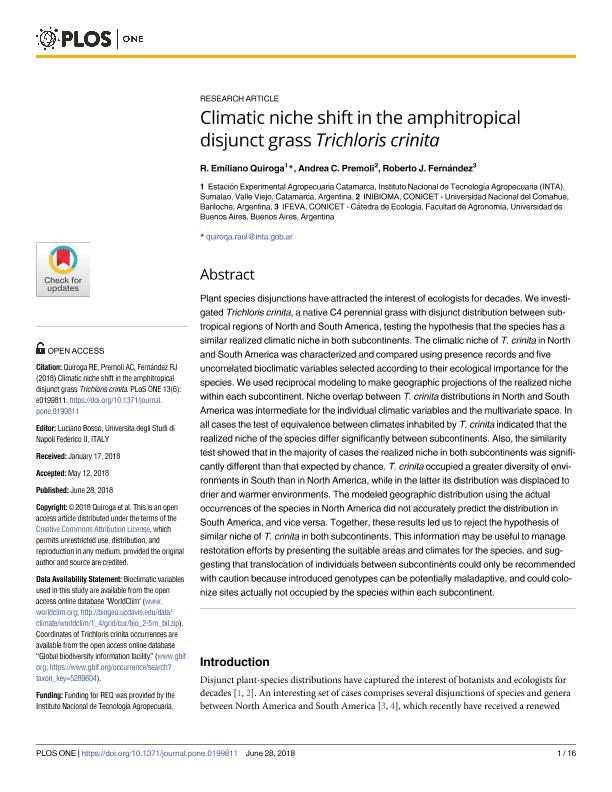Mostrar el registro sencillo del ítem
dc.contributor.author
Quiroga, Raul Emiliano

dc.contributor.author
Premoli Il'grande, Andrea Cecilia

dc.contributor.author
Fernandez Alduncin, Roberto Javier

dc.date.available
2020-01-02T22:01:30Z
dc.date.issued
2018-06
dc.identifier.citation
Quiroga, Raul Emiliano; Premoli Il'grande, Andrea Cecilia; Fernandez Alduncin, Roberto Javier; Climatic niche shift in the amphitropical disjunct grass Trichloris crinita; Public Library of Science; Plos One; 13; 6; 6-2018; 1-16
dc.identifier.issn
1932-6203
dc.identifier.uri
http://hdl.handle.net/11336/93331
dc.description.abstract
Plant species disjunctions have attracted the interest of ecologists for decades. We investigated Trichloris crinita, a native C4 perennial grass with disjunct distribution between subtropical regions of North and South America, testing the hypothesis that the species has a similar realized climatic niche in both subcontinents. The climatic niche of T. crinita in North and South America was characterized and compared using presence records and five uncorrelated bioclimatic variables selected according to their ecological importance for the species. We used reciprocal modeling to make geographic projections of the realized niche within each subcontinent. Niche overlap between T. crinita distributions in North and South America was intermediate for the individual climatic variables and the multivariate space. In all cases the test of equivalence between climates inhabited by T. crinita indicated that the realized niche of the species differ significantly between subcontinents. Also, the similarity test showed that in the majority of cases the realized niche in both subcontinents was significantly different than that expected by chance. T. crinita occupied a greater diversity of environments in South than in North America, while in the latter its distribution was displaced to drier and warmer environments. The modeled geographic distribution using the actual occurrences of the species in North America did not accurately predict the distribution in South America, and vice versa. Together, these results led us to reject the hypothesis of similar niche of T. crinita in both subcontinents. This information may be useful to manage restoration efforts by presenting the suitable areas and climates for the species, and suggesting that translocation of individuals between subcontinents could only be recommended with caution because introduced genotypes can be potentially maladaptive, and could colonize sites actually not occupied by the species within each subcontinent.
dc.format
application/pdf
dc.language.iso
eng
dc.publisher
Public Library of Science

dc.rights
info:eu-repo/semantics/openAccess
dc.rights.uri
https://creativecommons.org/licenses/by/2.5/ar/
dc.subject
Ecological Niches
dc.subject
Biogeography
dc.subject
Invasive Species
dc.subject
Rangelands
dc.subject.classification
Ecología

dc.subject.classification
Ciencias Biológicas

dc.subject.classification
CIENCIAS NATURALES Y EXACTAS

dc.title
Climatic niche shift in the amphitropical disjunct grass Trichloris crinita
dc.type
info:eu-repo/semantics/article
dc.type
info:ar-repo/semantics/artículo
dc.type
info:eu-repo/semantics/publishedVersion
dc.date.updated
2019-10-10T13:54:24Z
dc.journal.volume
13
dc.journal.number
6
dc.journal.pagination
1-16
dc.journal.pais
Estados Unidos

dc.journal.ciudad
San Francisco
dc.description.fil
Fil: Quiroga, Raul Emiliano. Instituto Nacional de Tecnología Agropecuaria. Centro Regional Catamarca-la Rioja; Argentina
dc.description.fil
Fil: Premoli Il'grande, Andrea Cecilia. Consejo Nacional de Investigaciones Científicas y Técnicas. Centro Científico Tecnológico Conicet - Patagonia Norte. Instituto de Investigaciones en Biodiversidad y Medioambiente. Universidad Nacional del Comahue. Centro Regional Universidad Bariloche. Instituto de Investigaciones en Biodiversidad y Medioambiente; Argentina
dc.description.fil
Fil: Fernandez Alduncin, Roberto Javier. Consejo Nacional de Investigaciones Científicas y Técnicas. Oficina de Coordinación Administrativa Parque Centenario. Instituto de Investigaciones Fisiológicas y Ecológicas Vinculadas a la Agricultura. Universidad de Buenos Aires. Facultad de Agronomía. Instituto de Investigaciones Fisiológicas y Ecológicas Vinculadas a la Agricultura; Argentina. Universidad de Buenos Aires. Facultad de Agronomía; Argentina
dc.journal.title
Plos One

dc.relation.alternativeid
info:eu-repo/semantics/altIdentifier/url/http://journals.plos.org/plosone/article?id=10.1371/journal.pone.0199811
dc.relation.alternativeid
info:eu-repo/semantics/altIdentifier/doi/http://dx.doi.org/10.1371/journal.pone.0199811
Archivos asociados
